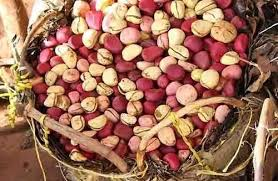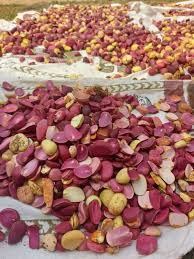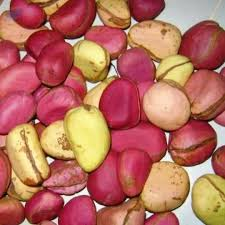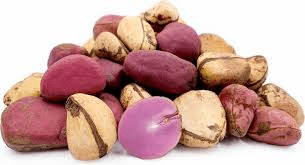Processing, packaging, and exporting kola nuts is a detailed process that ensures these nuts are delivered to markets in the best possible condition. The journey begins with harvesting kola nuts from the kola tree. The kola tree produces large pods that contain the kola nuts, which are actually seeds. Once the pods are ripe, they are harvested by hand or using tools to cut them from the tree. The nuts are then extracted from the pods.
After harvesting, kola nuts undergo a process called curing, which helps to develop their flavor and extend their shelf life. Curing usually involves drying the nuts in the sun or using a drying machine.
This process reduces the moisture content of the nuts, making them less prone to mold and spoilage. During curing, the nuts may also be roasted, which enhances their flavor and makes them more aromatic. Roasting is done by heating the nuts in an oven or roasting machine at a controlled temperature.
Once cured and roasted, the kola nuts are sorted and graded. Sorting involves removing any damaged or inferior nuts and separating them based on size and quality. Grading ensures that only the best nuts are selected for packaging and export. This step is crucial for maintaining the quality and consistency of the product.
The next step is packaging. Proper packaging is essential to protect kola nuts during transportation and to maintain their quality. Kola nuts are typically packaged in airtight bags or containers to keep out moisture, light, and air. Packaging materials should be durable to withstand the rigors of shipping. Labels on the packaging provide important information such as the product’s origin, processing date, and any relevant handling instructions.
Exporting kola nuts involves several important considerations. The nuts must be carefully packed to prevent damage during transport. Exporters must comply with various regulations and standards related to quality, safety, and labeling.
This includes providing necessary documentation such as certificates of origin and meeting the import requirements of the destination country. Working with shipping companies is also important to ensure timely and safe delivery.
Processing, packaging, and exporting kola nuts requires attention to detail at each stage to ensure that the nuts reach consumers in excellent condition. From harvesting and curing to sorting, packaging, and exporting, every step is crucial for maintaining the quality and flavor of the kola nuts. By following these best practices, producers can ensure that their kola nuts meet global standards and satisfy customers around the world.
How to Process Kola Nuts for Exportation

1. Harvesting: Kola nuts are harvested from mature kola trees. The nuts are typically collected when they are ripe and have turned a reddish-brown color. Ensure that only fully mature nuts are harvested to maintain quality.
2. Sorting: After harvesting, sort the kola nuts to remove any that are damaged, diseased, or of low quality. This step is crucial for ensuring that only the best nuts are processed for export.
3. Washing: Clean the sorted kola nuts thoroughly to remove any dirt or contaminants. Washing helps ensure the nuts are clean and ready for further processing. Use clean, potable water and avoid any abrasive methods that might damage the nuts.
4. Drying: Dry the washed kola nuts to reduce their moisture content and prevent mold growth. Spread the nuts out in a well-ventilated area or use mechanical dryers. Proper drying is essential for preserving the nuts during storage and transport.
5. Peeling: Remove the outer shell of the dried kola nuts. This can be done manually or with a peeling machine, depending on the scale of operation. Peeling helps in exposing the inner kernel and improves the appearance of the nuts.
6. Grinding (optional): Depending on market requirements, the peeled kola nuts can be ground into a powder. Grinding is often done if the nuts are intended for use in products like supplements or flavorings.
7. Sorting and Grading: Sort the peeled or ground kola nuts to remove any remaining impurities and grade them based on size and quality. High-quality nuts are sorted for premium markets, while lower-quality ones are set aside for other uses.
8. Packaging: Package the processed kola nuts in clean, airtight containers to protect them from moisture, pests, and contamination. The packaging should be durable enough to withstand transport.
9. Labeling: Label each package with essential information such as product name, origin, processing date, and any certifications. Proper labeling ensures compliance with export regulations and helps buyers identify the product.
10. Documentation: Prepare all necessary export documentation including certificates of origin, phytosanitary certificates, and quality assurance certificates. Accurate documentation is crucial for smooth customs clearance and compliance with international trade regulations.
Read Also: Bears: Description, Damages Caused, Control and Preventive Measures
How to Package Kola Nuts for Exportation

1. Choose Packaging Materials: Select high-quality, durable packaging materials that protect the kola nuts from moisture, air, and contaminants. Common options include vacuum-sealed bags, foil pouches, or sturdy cardboard boxes.
2. Measure Portions: Decide on portion sizes based on market requirements and customer preferences. Typical sizes include 500g, 1kg, or larger quantities for bulk buyers. Ensure portion sizes are consistent to maintain quality.
3. Seal Packages: Use appropriate sealing methods to ensure that packages are airtight. For vacuum-sealed bags, use a vacuum sealer to remove air and preserve freshness. Proper sealing helps prevent spoilage during transit.
4. Label Packages: Clearly label each package with essential information including the product name, weight, origin, and date of processing. Include any additional details required by the importing country, such as certifications or nutritional information.
5. Include Documentation: Attach copies of required export documents to the packages or place them inside the shipment. This includes certificates of origin, quality assurance certificates, and packing lists.
6. Inspect Packaging: Check that all packages are properly sealed, labeled, and free from defects. Ensure that there are no damaged or compromised packages to avoid issues during customs inspection.
7. Palletizing: For large shipments, arrange the packages on pallets. Ensure they are stacked evenly and secured with straps to prevent shifting during transport. Palletizing helps in handling and shipping efficiency.
8. Use Cushioning: If shipping in bulk or fragile containers, use cushioning materials such as bubble wrap or packing peanuts to protect the kola nuts from impact and damage.
9. Maintain Cleanliness: Ensure that the packaging area is clean and free from contaminants. This helps preserve the quality of the kola nuts and avoids cross-contamination.
10. Store Packages: Store the packaged kola nuts in a cool, dry place until they are ready for shipment. Avoid exposing the packages to direct sunlight or extreme temperatures to maintain quality.
How to Export Kola Nuts for Profits
1. Market Research: Conduct thorough market research to identify potential markets and understand demand for kola nuts. Look for regions with high consumption or emerging markets with growing demand.
2. Understand Regulations: Familiarize yourself with export regulations and requirements for the target market. This includes tariffs, import restrictions, and quality standards specific to kola nuts.
3. Find Buyers: Reach out to potential buyers or importers in your target market. Attend trade shows, join industry associations, and use online platforms to connect with buyers interested in kola nuts.
4. Set Pricing: Determine competitive pricing based on market conditions, production costs, and profit margins. Consider factors like quality, grade, and packaging when setting prices.
5. Negotiate Terms: Negotiate terms with buyers, including payment terms, delivery schedules, and contract conditions. Ensure both parties agree on these terms before finalizing the export deal.
6. Secure Logistics: Arrange for reliable logistics and transportation to ensure timely and safe delivery of kola nuts. Choose experienced logistics providers who specialize in handling agricultural products.
7. Monitor Quality: Continuously monitor the quality of your kola nuts to meet export standards. Implement quality control measures throughout processing and packaging to address any issues promptly.
8. Handle Documentation: Complete all required export documentation accurately and in compliance with international trade regulations. This includes preparing invoices, packing lists, and certificates of origin.
9. Promote Your Product: Invest in marketing and promotion to increase visibility and attract more buyers. Use online marketing, social media, and trade publications to reach a broader audience.
10. Evaluate and Adjust: Regularly review your export performance and customer feedback. Make adjustments to your strategy as needed to improve profitability and expand your market reach.
Read Also: Worm Infestation on Ruminant Animals: Symptoms and Treatment
Frequently Asked Questions (FAQ’s) About Kola Nuts

1. What are kola nuts used for? Kola nuts are used in traditional medicine, as a stimulant in beverages, and as a flavoring agent in various products. They are also culturally significant in many regions.
2. How are kola nuts processed? Kola nuts are harvested, sorted, washed, dried, peeled, and sometimes ground before packaging. Each step is crucial for maintaining quality and preparing the nuts for export.
3. What is the shelf life of kola nuts? When properly processed and packaged, kola nuts can last up to a year. However, their shelf life can be affected by storage conditions and packaging.
4. How should kola nuts be stored? Kola nuts should be stored in a cool, dry place away from direct sunlight and moisture. Proper storage helps preserve their quality and extend their shelf life.
5. What are the health benefits of kola nuts? Kola nuts contain caffeine and other stimulants, which can boost energy and alertness. They are also used in traditional medicine for various ailments.
6. Are there any side effects of consuming kola nuts? Excessive consumption of kola nuts can lead to side effects such as insomnia, increased heart rate, and digestive issues due to their caffeine content.
7. How do kola nuts differ from coffee beans? While both kola nuts and coffee beans contain caffeine, kola nuts are typically used for their stimulant properties and cultural significance, whereas coffee beans are mainly used to make coffee.
8. Can kola nuts be eaten raw? Kola nuts can be eaten raw, but they are often processed or used in products to enhance their flavor and effectiveness.
9. What countries are major producers of kola nuts? Major producers of kola nuts include Nigeria, Ghana, and other West African countries where the kola tree is native.
10. How are kola nuts exported? Kola nuts are exported by processing them to meet quality standards, packaging them appropriately, and completing the necessary export documentation for international trade.
Read Also: How to Graft an Avocado Tree to Produce Avocado Fruit

